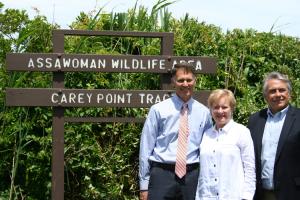Division of Fish & Wildlife dedicates tracts for use as habitat and recreation area
The Delaware Division of Fish and Wildlife recently dedicated three state-owned and -managed wildlife area tracts in honor of the families who previously owned the land and in recognition of the conservation, recreational and educational opportunities these acquisitions provide.
“A crucial part of the Division of Fish and Wildlife’s mission is to conserve lands and waters that provide habitat for the fish, wildlife and plant species that make Delaware unique,” said David Saveikis, Department of Natural Resources and Environmental Control's Division of Fish & Wildlife director.
“By partnering with landowners who are committed to preserving their properties for the future like the Carey, Matarese and Campanelli families, we can continue to add to Delaware’s public lands, which not only support our wildlife but also enrich our lives and those of our children and grandchildren by providing public hunting, fishing, nature study and educational access.”
Carey Point Tract, Assawoman Wildlife Area, Sussex County
The Carey family donated a 22-acre tract to the Division of Fish and Wildlife at the end of last year to serve as a wildlife sanctuary, incorporated into the Assawoman Wildlife Area in Sussex County’s Inland Bays region. It adjoins the Swann Keys community, which is on land once owned and used by the Carey family for grazing cattle.
The property is about two miles west of Fenwick Island within the Little Assawoman Watershed, fronting Dirickson Creek. Composed of tidal emergent wetlands, the tract provides salt-marsh habitat for a variety of species including waterfowl, herons, shorebirds, shellfish and fish while purifying water and protecting Swann Keys from tidal flooding.
"With the busy bay and ocean beach resorts just minutes away, the newly christened Carey Point Tract is like a little island of natural beauty, with marsh stretching out into Dirickson Creek," said Nancy Carey, one of the three Carey siblings who owned and donated the land.
“Just looking around during the dedication, I thought how beautiful this place is - you can’t help but feel refreshed just seeing it. Also, I noticed an abundance of wildlife - willet, blue heron, egrets and a variety of smaller birds. I can only imagine what is underneath what you can see, including periwinkles and other aquatic life,” Carey said, noting that she and her brothers, Andrew Carey and Asher Carey III, felt that with the land permanently preserved, people would be able to enjoy this beauty in perpetuity - benefiting people, property and the planet.
“In addition, we understand how wetlands protect the environment and surrounding communities by absorbing tidal waters and flooding,” Carey added. “So we’re entrusting this property to the state of Delaware, because it has the resources to protect this productive, protective and beautiful resource for generations to come.”
The original tracts at the heart of Assawoman Wildlife Area were acquired by the state of Delaware from the federal government in 1957 as one of Delaware’s first managed wildlife areas. Today, Assawoman Wildlife Area encompasses more than 3,100 acres of tidal marsh, impounded wetlands, forest lands and grasslands. Visitors to Assawoman Wildlife Area’s main unit can enjoy auto tours, fishing, crabbing, wildlife and birdwatching, hiking or biking dirt roads, canoeing, kayaking, and deer, waterfowl, turkey, dove and small game hunting in season. Amenities include a fishing/crabbing pier, picnic pavilions, an observation tower and two boat ramps for smaller power boats.
Other dedications included the Matarese Tract in the Woodland Beach Wildlife Area in Kent County and the Julia Anne Campanelli Tract, Blackbird Reserve Wildlife Area in New Castle County.























































